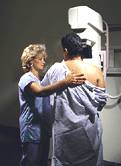
WEDNESDAY, June 23 (HealthDay News) — A new report challenges the 2009 recommendation from the U.S. Preventive Services Task Force that women between 40 and 49 who are not at high risk of breast cancer can probably wait to get a mammogram until 50, and even then only need the exam every two years.
A well-known Harvard Medical School radiologist, writing in the July issue of Radiology, says telling women to wait until 50 is flat out wrong. The task force recommendations, he says, are based on faulty science and should be revised or withdrawn.
“We know from the scientific studies that screening saves a lot of lives, and it saves lives among women in their 40s,” said Dr. Daniel B. Kopans, a professor of radiology at Harvard Medical School and senior radiologist in the breast imaging division at Massachusetts General Hospital in Boston.
The U.S. Preventive Services Task Force (USPSTF) said its recommendation, which sparked a firestorm of controversy, was based in science and would save many women each year from unnecessary worry and treatment.
But the guidelines left most women confused. The American Cancer Society continued to recommend annual mammograms for women in their 40s, and young breast cancer survivors shared powerful stories about how screening saved their lives.
One main problem with the guidelines is that the USPSTF relied on incorrect methods of analyzing data from breast cancer studies, Kopans said.
The risk of breast cancer starts rising gradually during the 40s, 50s and gets higher still during the 60s, he said. But the data used by the USPSTF lumped women between 40 and 49 into one group, and women between 50 and 59 in another group, and determined those in the younger group were much less likely to develop breast cancer than those in the older group.
That may be true, he said, except that assigning age 50 as the “right” age for mammography is arbitrary, Kopans said. “A woman who is 49 is similar biologically to a woman who is 51,” Kopans said. “Breast cancer doesn’t monitor your age. There is nothing that changes abruptly at age 50.”
Other problems with the USPSTF guidelines, Kopans said, include the following:
- The guidelines cite research that shows mammograms are responsible for a 15 percent reduction in mortality. That’s an underestimate. Other studies show screening women in their 40s can reduce deaths by as much as 44 percent.
- Sparing women from unnecessary worry over false positives is a poor reason for not screening, since dying of breast cancer is a far worse fate. “They made the subjective decision that women in their 40s couldn’t tolerate the anxiety of being called back because of a questionable screening study, even though when you ask women who’ve been through it, most are pleased there was nothing wrong, and studies show they will come back for their next screening even more religiously,” Kopans said. “The task force took the decision away from women. It’s incredibly paternalistic.”
- The task force recommendation to screen only high-risk women in their 40s will miss the 75 percent of breast cancers that occur among women who would not be considered high risk, that is, they don’t have a strong family history of the disease and they don’t have the BRCA1 or BRCA2 genes known to heighten cancer risk.
Since the furor over the guidelines, the USPSTF has backed off some of the original wording, amending language to make it clearer that the decision to have a mammogram between 40 and 49 is an “individual one,” said Dr. Ned Calonge, USPSTF chair and chief medical officer of the Colorado Department of Public Health.
Calonge is co-author of an editorial in the same issue of Radiology.
“It was a poor communication to a lay audience,” Calonge said. “The task force recommends against automatic screening. We think the knowledge of what can be gained versus what is risked is an important discussion to have with women in that age group.”
The drawbacks include unnecessary additional testing, biopsies, treatment that will provide no health benefit and, yes, anxiety, he said.
As for the benefits, mammography can save lives, but perhaps not as many as women may believe, Calonge said. Studies show that for every 1,000 40-year-old women alive today, 30 would eventually die of breast cancer, he added.
Beginning mammography at age 50 and continuing it biennially to age 74 can reduce those deaths by seven. Or, in other words, 23 will still die of breast cancer despite screening. Beginning mammography at age 40 can reduce deaths by one more, to 22.
“It’s clear mammogram is a useful tool in the fight against breast cancer and that the appropriate use of mammogram will prevent some deaths,” Calonge said. “But the test is far from perfect, the benefits are smaller than many people assume, and women should know there are drawbacks.”
Both Kopans and Calonge agree that complicating all analyses is the fact that early detection of breast cancer doesn’t necessarily translate into prolonging life. Breast cancer tumors can be highly aggressive, and even early detection won’t mean a longer life. On the other hand, some tumors are extremely slow growing and might never cause a problem even if left untreated, Kopans said.
The problem is, doctors don’t know which tumor is which, Kopans stated.
“It’s true that mammography is far from perfect,” Kopans said. “But it’s the only test for breast cancer we have that has been shown to save lives. In the United States, we’ve seen a 30 percent decrease in the breast cancer death rate since the beginning of mammography screening in the mid-1980s.”
In theory, the concept of discussing mammography with your doctor is a good one, Kopans said. But with primary care appointments typically lasting under 10 minutes, doctors are not going to discuss randomized clinical trials with you, he added. Instead, they will rely on guidelines such as the USPSTF report, he said.
More information
Read the USPSTF guidelines here.

